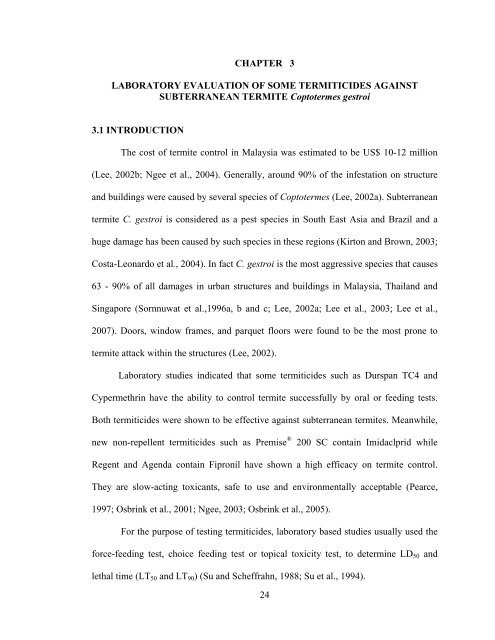SALAH SALEM OBAID GURBEL - ePrints@USM
SALAH SALEM OBAID GURBEL - ePrints@USM
SALAH SALEM OBAID GURBEL - ePrints@USM
You also want an ePaper? Increase the reach of your titles
YUMPU automatically turns print PDFs into web optimized ePapers that Google loves.
CHAPTER 3<br />
LABORATORY EVALUATION OF SOME TERMITICIDES AGAINST<br />
SUBTERRANEAN TERMITE Coptotermes gestroi<br />
3.1 INTRODUCTION<br />
The cost of termite control in Malaysia was estimated to be US$ 10-12 million<br />
(Lee, 2002b; Ngee et al., 2004). Generally, around 90% of the infestation on structure<br />
and buildings were caused by several species of Coptotermes (Lee, 2002a). Subterranean<br />
termite C. gestroi is considered as a pest species in South East Asia and Brazil and a<br />
huge damage has been caused by such species in these regions (Kirton and Brown, 2003;<br />
Costa-Leonardo et al., 2004). In fact C. gestroi is the most aggressive species that causes<br />
63 - 90% of all damages in urban structures and buildings in Malaysia, Thailand and<br />
Singapore (Sornnuwat et al.,1996a, b and c; Lee, 2002a; Lee et al., 2003; Lee et al.,<br />
2007). Doors, window frames, and parquet floors were found to be the most prone to<br />
termite attack within the structures (Lee, 2002).<br />
Laboratory studies indicated that some termiticides such as Durspan TC4 and<br />
Cypermethrin have the ability to control termite successfully by oral or feeding tests.<br />
Both termiticides were shown to be effective against subterranean termites. Meanwhile,<br />
new non-repellent termiticides such as Premise ® 200 SC contain Imidaclprid while<br />
Regent and Agenda contain Fipronil have shown a high efficacy on termite control.<br />
They are slow-acting toxicants, safe to use and environmentally acceptable (Pearce,<br />
1997; Osbrink et al., 2001; Ngee, 2003; Osbrink et al., 2005).<br />
For the purpose of testing termiticides, laboratory based studies usually used the<br />
force-feeding test, choice feeding test or topical toxicity test, to determine LD 50 and<br />
lethal time (LT 50 and LT 90 ) (Su and Scheffrahn, 1988; Su et al., 1994).<br />
24







![[Consumer Behaviour] - ePrints@USM](https://img.yumpu.com/21924816/1/184x260/consumer-behaviour-eprintsusm.jpg?quality=85)








